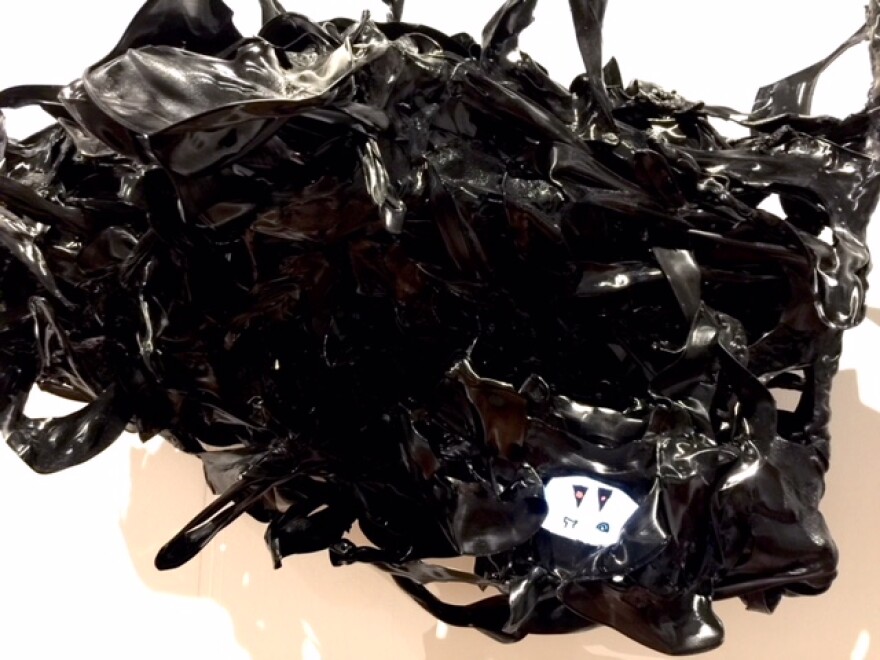This semester, six students will be graduating with Master of Fine Arts degrees from UH Manoa. They’ve spent the last three years intently developing their skills and creativity with video, printmaking, glass, vinyl, photography and more to be ready to face a changing job market, MFA in hand. HPR’s Noe Tanigawa reports.
The University of Hawai'i at Manoa's Master of Fine Arts exhibition continues at the Art Department Gallery through April 6th, 2018.

The exhibition is remarkably diverse this year, with works at a generally high level of execution. Mostly installations, you could note a preference for experience over individual products.
Nisha Pinjani is Pakistani from Karachi, here with the East West Center to get her Masters in printmaking. She says there’s a lot of Western scholarship about South Asia…
Pinjani: It was always, victimized, women are oppressed, we need to save them.
Pinjani says, there are problems, yes.
Pinjani: They might need help, they don’t need somebody else to come and save them. That is definitely not the narrative I would want to perpetuate. That idea of agency, definitely I wanted to translate in my work. That’s why I did the floor drawing.
Pinjani’s installation involves translucent hanging panels with Islamic looking designs that betray quite a twist, close up. On the floor, Pinjani has laid out interlocking geometric patterns of tiny rice beads. The hangings and floor patterns direct movements without putting up any walls.

Pinjani: When you walk through the installation you realize you have to access the space in my terms. So there’s no aggressive, violent wall there, but here’s a psychological limitation you experience.
Pinjani says women obey unseen conventions, unwritten rules all the time, and so operate differently from men in public spaces.
Pinjani: So my installation is kind of a map of my own head. I’m talking about my own agency and I wanted to recognize myself and other people and their agency.
Nisha plans to return to Karachi, and has sent out applications for various next steps. She worked in textile and product design previously, and is thinking about combining that with teaching, for income. She is hoping to continue her art practice in public spaces, without the pressure of needing financial compensation.
Nisha says the contemporary art scene is picking up in Karachi, with a new Biennial and more galleries opening up. She says the art scene here has developed in the three years she has been in Honolulu, with a decided increase in opportunities to show and participate in various events.
On the other side of the UH MFA exhibit, Atis Puampai applied himself to two abiding interests:
Which was making cameras and photographing time and motion. I was into this technique called the slit scan technique. It’s a type of photographing technique where you pretty much only photograph one spacial line. As the film moves, that spacial line builds the x-axis of the photograph, so that the x-axis is time, and the y is space. Usually in a regular photograph, it’s space and space.
Puampai is a DIY style tinkerer with his grey matter in space and time.

In: I’ve always interested by the Ceti image, where they’re trying to teach aliens who we are, where we’re from, you know. I feel like through photography, I’m trying to do the same thing.
For one of his graduate projects, Puampai jury rigged a Gameboy camera to photograph the movement of the earth. He did this by stop action, manually triggering his shutter while keeping it trained on the sun for the entire course of a day. The sun in focus, everything else blurring out, Could aliens figure out we’re orbiting the sun?---
I think they can deduce it if they think about it enough.
Of course my thesis work is more directed to the age of sunlight.

Old sunlight is all we get here—Puampai has learned that photons generated in the sun’s core can take ten to a hundred thousand years to break the surface before traveling at the speed of light to us.
Regarding why you’d want to be stranded in a dystopian future with a Master of Fine Arts? Puampai ended up making a little solar heater for the Gameboy camera, and goggles so the sun wouldn’t blow out the lens.
Everything was scavenged. Even the Gameboy camera, my friend Matt Tsuda, he lent me that. All the springs and screws, they’re all from broken printers and cameras. It’s still within my artistic practice!
Puampai is sending out applications for lectureships and residencies. Residencies, time spent working at and with prestigious art centers, are a key way that artists move up the recognition roster these days. He is also planning a reconnaissance trip to Tokyo, where he plans to meet with art world figures he met in grad school. That’s what grad school is for!
In the robot friendly future, some futurists anticipate a world where labor will be decoupled from income and self-worth. Conceivably many more of us will be able to pursue such wonderings.

Concurrently in the Commons Gallery, artists Margery Amdur (Philadelphia, PA), Diana Baumbach (Laramie, WY), Josephine Cachemaille (Auckland, New Zealand), Michelle Forsyth (Toronto, Canada), Wendy Kawabata (Honolulu, HI), and Io Palmer (Pullman, WA) isolate and subvert materials to pose questions about the role of materials and the handmade in the 21st century. Their show, Material Shift, runs through April 6, 2018.




